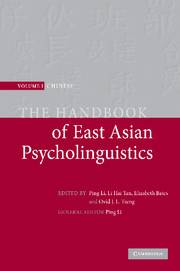Book contents
- Frontmatter
- Contents
- List of figures
- Notes on contributors
- Preface
- Introduction: new frontiers in Chinese psycholinguistics
- Part I Language acquisition
- Part II Language processing
- 14 Word-form encoding in Chinese speech production
- 15 Effects of semantic radical consistency and combinability on Chinese character processing
- 16 Eye movement in Chinese reading: basic processes and crosslinguistic differences
- 17 The Chinese character in psycholinguistic research: form, structure, and the reader
- 18 Perception and production of Mandarin Chinese tones
- 19 Phonological mediation in visual word recognition in English and Chinese
- 20 Reading Chinese characters: orthography, phonology, meaning, and the Lexical Constituency Model
- 21 Processing of characters by native Chinese readers
- 22 L2 acquisition and processing of Mandarin tones
- 23 The comprehension of coreference in Chinese discourse
- 24 Lexical ambiguity resolution in Chinese sentence processing
- Part III Language and the brain
- Epilogue: a tribute to Elizabeth Bates
- References
- Name index
- Subject index
17 - The Chinese character in psycholinguistic research: form, structure, and the reader
Published online by Cambridge University Press: 05 June 2012
- Frontmatter
- Contents
- List of figures
- Notes on contributors
- Preface
- Introduction: new frontiers in Chinese psycholinguistics
- Part I Language acquisition
- Part II Language processing
- 14 Word-form encoding in Chinese speech production
- 15 Effects of semantic radical consistency and combinability on Chinese character processing
- 16 Eye movement in Chinese reading: basic processes and crosslinguistic differences
- 17 The Chinese character in psycholinguistic research: form, structure, and the reader
- 18 Perception and production of Mandarin Chinese tones
- 19 Phonological mediation in visual word recognition in English and Chinese
- 20 Reading Chinese characters: orthography, phonology, meaning, and the Lexical Constituency Model
- 21 Processing of characters by native Chinese readers
- 22 L2 acquisition and processing of Mandarin tones
- 23 The comprehension of coreference in Chinese discourse
- 24 Lexical ambiguity resolution in Chinese sentence processing
- Part III Language and the brain
- Epilogue: a tribute to Elizabeth Bates
- References
- Name index
- Subject index
Summary
Introduction
Theories of lexical access and orthographic processing must accommodate an obvious difference between alphabetic/syllabic systems and logographic systems: the componential units of the latter encode semantic information. Although linguistic history has known several logographic and hybrid-logographic systems (e.g. Ancient Egyptian, Sumerian cuneiform, Mayan, Sino-Vietnamese, and Sino-Japanese), written Chinese stands alone as the only system that is both primarily logographic and the chief written system of a living language. Despite a “phonographic tendency,” novel Chinese characters are not freely formed from existing components; Chinese is not “spelled.” Furthermore, the existing phonographic representation is incomplete; phonological information is encoded only loosely at the level of the component, only in some characters, and in phonological units that span a greater distance than the phoneme. The looseness of the phonological mapping arises in part because phonographic Chinese characters represent the multiple phonologies of the speakers who standardized them thousands of years ago. Nevertheless, present-day readers of Chinese manage to cope with the extreme fossilization of its ancient written forms across centuries of phonological change. Therefore theories of reading and word recognition must account for the apparent success of the Chinese reader. In the present chapter we discuss the foregoing issues and their implications for research on the reading of Chinese.
Specifically, we identify several issues that arise when one investigates the processing of Chinese characters, issues that are not necessarily obvious to the non-Chinese psycholinguist.
- Type
- Chapter
- Information
- The Handbook of East Asian Psycholinguistics , pp. 195 - 208Publisher: Cambridge University PressPrint publication year: 2006
- 9
- Cited by



